致用英语综合教程 Unit 1
- 格式:ppt
- 大小:2.87 MB
- 文档页数:28
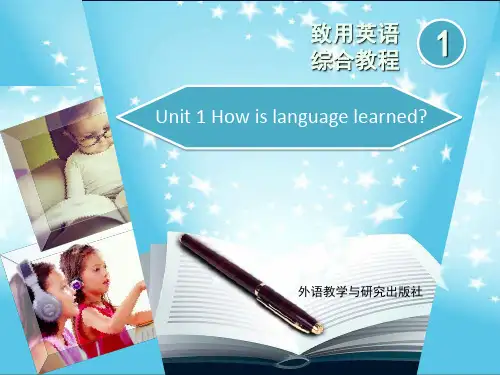
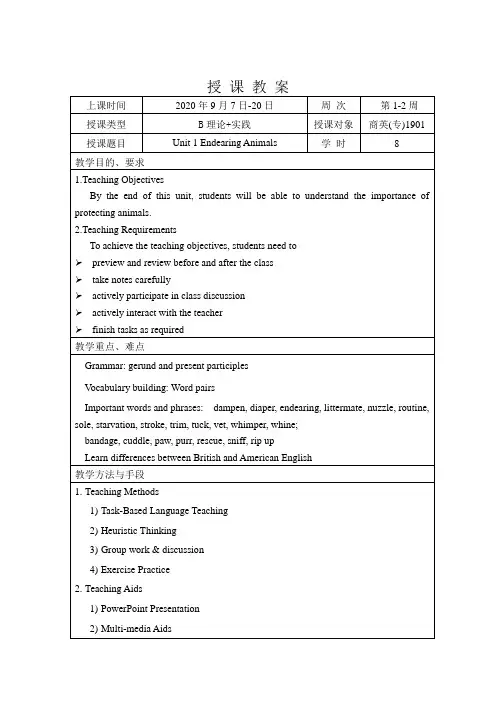
![致用英语B1Unit 1[1]](https://uimg.taocdn.com/9e0bd5f2a32d7375a41780eb.webp)
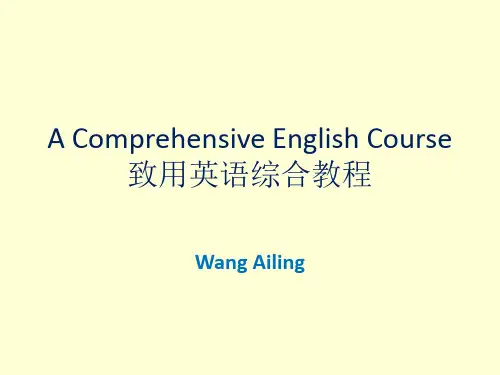
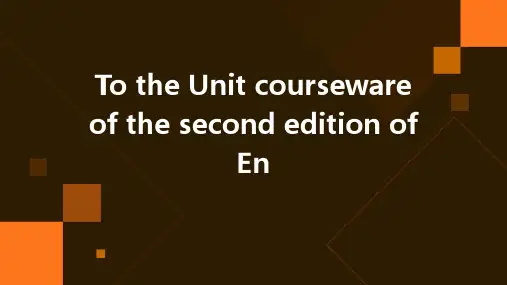

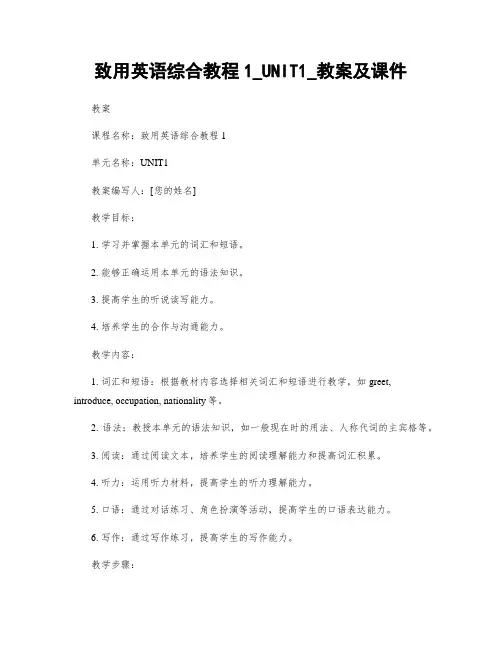
致用英语综合教程1_UNIT1_教案及课件教案课程名称:致用英语综合教程1单元名称:UNIT1教案编写人:[您的姓名]教学目标:1. 学习并掌握本单元的词汇和短语。
2. 能够正确运用本单元的语法知识。
3. 提高学生的听说读写能力。
4. 培养学生的合作与沟通能力。
教学内容:1. 词汇和短语:根据教材内容选择相关词汇和短语进行教学,如greet, introduce, occupation, nationality等。
2. 语法:教授本单元的语法知识,如一般现在时的用法、人称代词的主宾格等。
3. 阅读:通过阅读文本,培养学生的阅读理解能力和提高词汇积累。
4. 听力:运用听力材料,提高学生的听力理解能力。
5. 口语:通过对话练习、角色扮演等活动,提高学生的口语表达能力。
6. 写作:通过写作练习,提高学生的写作能力。
教学步骤:步骤一:导入(5分钟)教师通过展示一些图片或物品,引起学生对本单元主题的兴趣,并用简单的英语进行引导和问答,激发学生的学习热情。
步骤二:词汇和短语教学(15分钟)教师通过图片、示范和实物等多种形式,教授本单元的词汇和短语,并进行相关的练习,如单词拼写、词义选择等。
步骤三:语法教学(15分钟)教师通过示例句和练习,教授本单元的语法知识,如一般现在时的用法、人称代词的主宾格等,并帮助学生理解和掌握相关的语法规则。
步骤四:阅读和听力训练(20分钟)教师播放相关的听力材料,让学生听并回答问题,提高学生的听力理解能力。
随后,教师分发阅读材料,让学生阅读并回答相关问题,培养学生的阅读理解能力。
步骤五:口语练习(20分钟)教师组织学生进行对话练习,让学生运用本单元的词汇和语法知识进行实际对话。
教师可以提供一些情境,让学生进行角色扮演,加强口语表达能力。
步骤六:写作训练(15分钟)教师布置写作任务,让学生根据所学内容进行写作练习。
教师可以提供一些写作提示和范文,引导学生进行写作,并对学生的作文进行批改和评价。

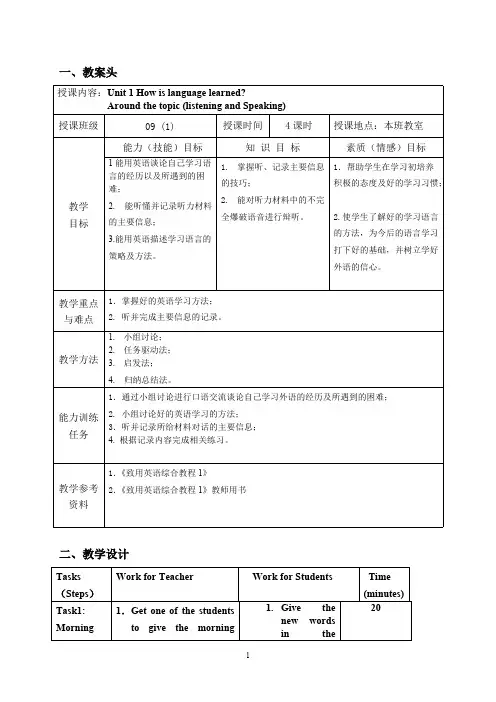
一、教案头授课内容:Unit 1 How is language learned?Around the topic (listening and Speaking)授课班级09 (1)授课时间4课时授课地点:本班教室能力(技能)目标知识目标素质(情感)目标教学目标1能用英语谈论自己学习语言的经历以及所遇到的困难;2.能听懂并记录听力材料的主要信息;3.能用英语描述学习语言的策略及方法。
1. 掌握听、记录主要信息的技巧;2. 能对听力材料中的不完全爆破语音进行辩听。
1.帮助学生在学习初培养积极的态度及好的学习习惯;2.使学生了解好的学习语言的方法,为今后的语言学习打下好的基础,并树立学好外语的信心。
教学重点与难点1.掌握好的英语学习方法;2.听并完成主要信息的记录。
教学方法1.小组讨论;2.任务驱动法;3.启发法;4. 归纳总结法。
能力训练任务1.通过小组讨论进行口语交流谈论自己学习外语的经历及所遇到的困难;2. 小组讨论好的英语学习的方法;3.听并记录所给材料对话的主要信息;4. 根据记录内容完成相关练习。
教学参考资料1.《致用英语综合教程1》2.《致用英语综合教程1》教师用书二、教学设计Tasks (Steps)Work for Teacher Work for Students Time(minutes)Task1: Morning 1.Get one of the studentsto give the morning1.Give thenew wordsin the20report report to the wholeclass;2.Talk about the topic orcomment on their jobs.report;2.Report tothe wholeclass;3.Ask andanswer thequestions.Task 2: Discussion 3.Talk about theexperience of learningEnglish and thedifficulties that evermet while learning;4.Divide the class intosmall groups and getstudents to share theirown experiences oflearning English;5.Invite some to sharewith the whole class.1.Talk about theexperiences oflearning Englishin English;2.Some volunteersshare with theclass.20Task 3: pre-listening activities 1.Get the individual tofinish a quiz.2.Read the scoringmethods andexplanations to theclass.3.Get the Ss to discuss onthe topic: What makesa good Englishlearner ?4.Do class feedback andwrite down the Ss’opinions on the Bb.1.Finish the quiz;2.Count the pointsthey’ve got andfigure out howgood languagelearners they are.3.Discuss in groupsof 4 and preparea presentation infront of class.40Task 4: Discussion 1.Have the students workin groups to discuss theways to learn Englishwell and let them write1.Work in groups todiscuss the waysto learn Englishwell and let them35down;2.Make each groupswrite the ways on theBb;3.Get them to discusswhich ways are the bestand let them talk abouttheir opinions.write down;2.Discuss the bestways to help themto learn English.Task 5: while-listening activities 1. Tell students what theyare going to listen , makethem get ready;2. Ask students to read thequestions first beforelistening;3. Play the recording andencourage them to takenotes while listening;4. Guide them to listen tothe recording three times;5. Get students to checktheir answers..1. Listen for the 1sttime and try to pickout the sameinformation fromthe listeningmaterial as thesuggestions listed onthe Bb.2. Listen for the 2ndtime to note downthe advice. 3. Listenfor the 3rd time tocheck the answers.4. Compare theanswers in pairs.40Task 6 : post-listening activities 1. Play the recording andget the Ss to repeat.2. Get the Ss to discuss ingroups of 4 on Mr.Martin’s opinions.1. Listen and repeat tocorrect the diction.2. Discuss in groups of 4.20Summary Summarize what studentshave learned in this lesson,point out what they shouldmaster.4Homework Pre-learn the words appeared in the word list.1三、教学后记1. 讲课之前让学生用英语简单的介绍一下自己,看看学生的实际水平并相互熟悉,使课堂气氛轻松;2. 在听力练习开始之前,先让学生简单地讨论一下自己的英语学习经历并谈论自己在学习中所遇到的难题以及解决办法,有助于学生更好地抓住听力材料中的关键内容。
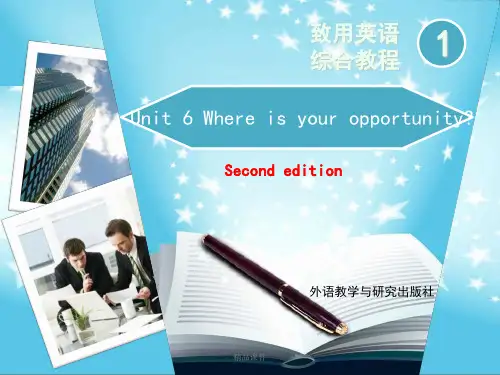
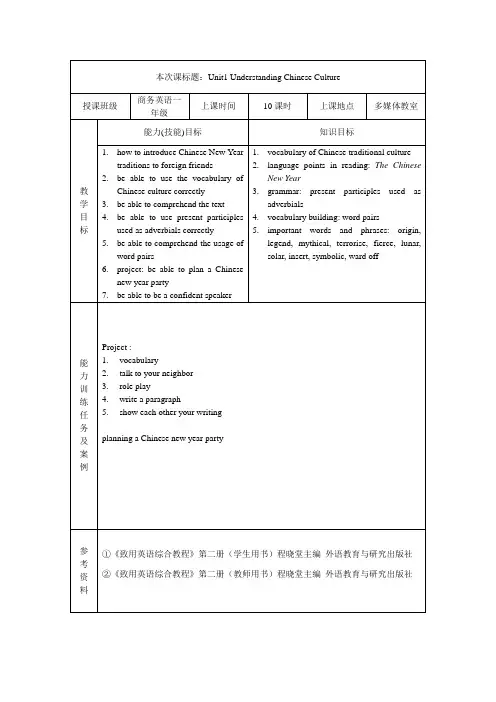
Section One Around the topicStep 1 Topic introduction:Many Chinese students find it very difficult to introduce Chinese culture to foreign friends.The biggest problem is that they don’t know how to express their understanding about Chinese culture or how to explain some typical concepts in Chinese culture. Chinese learners of English as a foreign language should not only study western cultures, but also deepen their understanding of Chinese culture, so that they can introduce it to the outside word.Step 2 Your ideasWork in groups or pairs and discuss the following questions1)Why is spring Festival so important for the Chinese people?2)What do you usually do during the Spring Festival3)Are there any special celebration activities in your hometown during Spring Festival?4)In what ways do you think the Spring Festival has Changed?How much do you know about the Chinese New Year?A.Which day in the 15-day celebration is for the sons-in-laws to pay a visit to theirparents-in-law?The third and fourth days.B. What is the fifth day called?Po Woo.C. How many kinds of traditional New Year food do you know?Dumplings, a whole fish, chicken, New Year cake…D. Do we use knives or scissors on New Year's Day?NO. They may cut off fortune.E. What fruit do we usually use as a decoration during the Spring Festival?Oranges and Tangerines. They are symbols for abundant happiness.Step 3 VocabularyThere are some special things about Spring Festival, which are difficult to translate into English. Here are some English words and expressions related to the Spring Festival. Try to get their meanings.Remind students that names of some typical Chinese things do not have exact equivalents in English. Ask them to guess the meaning of the English words and phrases related to theThe teacher can offer students a particular situation for students to practice in which students can give a brief talk with some of the words in the table above so that they can master a better usage of these words.Step 4 Listening and speakingAsk students to read the questions first. Then play the recording and encourage them to take notes while listening.1.Q: What are they talking about?A: They are talking about the Spring Festival.2.Q: How did Li Ming spend his holiday?A: Li Ming spent his holiday with his family in his hometown.3.Q: What is Susan curious about?A: Susan is curious about how Chinese people celebrating their Spring Festival.4.Q: What make the Spring Festival different from other holidays?A: Giving presents and staying with the family.5.Q: What do Chinese People do on the Eve of the Spring Festival according to the recording?A: In the past, all the members of a family would stay at home making dumplings together.Now many people enjoy watching TV. During the day, children wear their new clothes. The evening is usually spent playing games, talking, eating and drinking.Step 5 A quizDuring the Spring Festival, some things are believed to bring good luck for the new year, while other things might bring bad luck. Read the items in the table below and decide whether they bring good luck or bad luck. When you finish, compare your answers in pairs.This quiz is just for fun. Remind students that we should not be superstitious and the dos and don’ts during the Spring Festival are only parts of our traditions and customs. We should hold a right attitude towards them.Ask students to do the exercise first based on their own understanding and then compare their answers with their partners’. They may discuss them if necessary. When they finish, you may show and explain answers.Section Two ReadingThis section introduces the tradition of the Chinese New Year. By studying it, students will learn more about the legend of Nian and traditional Chinese New Year celebration activities. Most importantly, students will learn how to introduce the Chinese New Year to foreign friends.Step 1 Pre-reading tasksBefore you read, discuss the following questions in groups:1.Do you know why we call the Spring Festival “Nian”?2.Do you know why we Chinese celebrate the New Year at a different time from the Westernworld?Read the instruction as a class. Divide students into groups. Ask them to discuss the questions. Activate their prior knowledge of the Spring Festival and encourage them to share informationwith others. Pick some volunteers to answer these tow questions as representatives of their group. Step 2 Text illumination1)Ask several students to read the whole text in order to check whether they preview thetext and get a general understanding bout it or not beforehand.2)Ask students to summarize the text3)The teacher can put the comprehension check either before or after illuminating the textaccording to the needs of class and the students’ comprehension ability.4)Illuminate the text, during the process of which the teacher can encourage students tohighlight or underline the important parts when they read the text in detail. Try to explain that it can help students to grasp the important details and review important points Language points:1. legend n.story handed down from the past, especially one that may not be true 传奇,传说e.g. The legend of Robin Hood is well-known.2. mythical adj. existing only in an ancient story, imagined or invented 神话的,虚构的e.g. Qi Lin is a mythical Chinese creature which is similar to a unicorn.myth n. 神话e.g. ancient Greek myths3. terrorise v. to fill or overpower with terror, to terrify 使惊恐不安,恐吓e.g. The local gangs terrorised the neighborhood.4. fierce adj. violent and angry 凶猛的,凶狠的e.g. Swans are always fierce in defense of their young.The leopard looks fierce.5. lunar adj. determined or measured in reference to the moon 根据月亮决定或测定的e.g. The Chinese New Year falls on lunar January, 1st.6. solar adj. determined or measured in reference to the sun 根据太阳决定或测定的e.g. Solar energy is one kind of important energy nowadays.7. insert v. to put or set into, between, or among 插入,嵌入e.g. The editor inserted an advertisement in the newspaper.insert a key into a lock8. symbolic adj. representing a particular idea or quality 象征的,符号的e.g. The cross is symbolic of Christianity9. ward off to keep away (somebody/something that is dangerous or unpleasant) 挡开,避开e.g. He carried a gun to ward off possible attacks.Step 3 Post-reading exercises1.What is the significance of the following things during the Spring Festival?2.Discussion:Read the instruction as a class. Divide students into groups of four. Ask them to discuss these questions. Get feedback when they finish. Try to encourage them to express their opinions thoroughly in English.3.V ocabulary and structureThis part is about some vocabulary and structure exercises related to the text. Ask students to finish them independently beforehand. Check their answers in class. Try to encourage them to explain by themselves to check whether they fully understand the exercises or not. The teacher is supposed to give some explanations if necessary.A.Work out the meanings of the underlined words with the help of the context.B.Fill in the blanks with the words below. Change the form where necessary.plete each pair of the sentences with the correct form of the same verb, one as apresent participle (-ing) and the other as a past participle (-ed).4.WritingRead the instruction as a class. Leave the writing task as homework. Check their work next time.Write down your experience about the Spring Festival. The following questions may help you to come up with some ideas.1)How does your family prepare for the Spring Festival?2)What traditional activities does your family do to celebrate the Spring Festival?3)What special activity do you like most when you are celebrating the Spring Festival?Section Three language in use: present participles used as adverbialsStep 1 test your grammarThe aim of this practice is to make students aware of the present participles used as adverbials. Based on their study of the text, they may gain a deeper understanding by doing these exercises. Try to encourage students to explain by themselves through recalling and understanding of this grammatical phenomenon.Step 2 illumination and developmentBriefly explain the grammatical knowledge of participles. Then ask students to finish these exercises. Check their work when they finish.一、现在分词做状语(表原因,时间,条件,让步,行为方式,伴随状况)现在分词与主句的主语一致,且形成主谓关系,就是说现在分词的动作发出者是主句的主语。
一、教案头二、教学设计三、教学后记1. 讲课之前让学生用英语简单的介绍一下自己,看看学生的实际水平并相互熟悉,使课堂气氛轻松;2. 在听力练习开始之前,先让学生简单地讨论一下自己的英语学习经历并谈论自己在学习中所遇到的难题以及解决办法,有助于学生更好地抓住听力材料中的关键内容。
一、教案头二、教学设计三、教学后记文章不难,但很有用。
大部分学生在自读之后都已理解文章大意,重在让学生结合内容发表自己的观点,让学生将读与说结合起来,有益于培养学生学习的兴趣,从而全面掌握文章大意。
教学资料:Language points:1.factor: n. something that influences or causes a situatione.g. The rise in crime is mainly due to social and economic factors.2. process: n. a series of actions that are done in order to achieve a particularresulte.g. Repetition can help the learning process.v. to make food, materials, or goods ready to be used or solde.g. Milk can be processed in many ways.3. tend: v. if something tends to happen, it happens often and is likely to happen againe.g. People tend to need less sleep as the get older.4. under no circumstances/ in no circumstances: something must definitely not happene.g. under no circumstances are you to go out.5. under/given the circumstances/ in the circumstances: a particular situation makes an action ,decision, etc. necessary, acceptable, or true when it would not normally bee.g. It’s the best result that could be expected under the circumstances.6. take charge of : to have control of or responsibility for a group of people or an activitye.g. Owens came in and took charge of the situation.7. approach: n.(1). A method of doing something or dealing with a probleme.g. a new approach to teaching language(2). The approach of a particular time or event is the fact that it is getting closere.g. It’s a sign of the approach of middle age.8. intuitive: adj. an intuitive idea is based on a feeling rather than on knowledge or factse.g. He seemed to have an intuitive awareness of how I felt.一、教案头二、教学设计三、教学后记可数名词与不可数名词内容相对简单,但内容也不少,要求学生掌握俩者的区别并灵活使用,这需要通过一些练习来巩固。
备注:1.页面大小可自行添减,每上一次课写一份上述格式教案,一次课一般2个学时。
2.近三年参加工作的青年教师必须写详案。
3.手写教案格式参照表格内容。
备注:1.页面大小可自行添减,每上一次课写一份上述格式教案,一次课一般2个学时。
2.近三年参加工作的青年教师必须写详案。
3.手写教案格式参照表格内容。
1.页面大小可自行添减,每上一次课写一份上述格式教案,一次课一般2个学时。
2.近三年参加工作的青年教师必须写详案。
3.手写教案格式参照表格内容。
备注:1.页面大小可自行添减,每上一次课写一份上述格式教案,一次课一般2个学时。
2.近三年参加工作的青年教师必须写详案。
3.手写教案格式参照表格内容。
备注:1.页面大小可自行添减,每上一次课写一份上述格式教案,一次课一般2个学时。
2.近三年参加工作的青年教师必须写详案。
3.手写教案格式参照表格内容。
职业技术学院教案备注:1.页面大小可自行添减,每上一次课写一份上述格式教案,一次课一般2个学时。
2.近三年参加工作的青年教师必须写详案。
3.手写教案格式参照表格内容。
职业技术学院教案备注:1.页面大小可自行添减,每上一次课写一份上述格式教案,一次课一般2个学时。
2.近三年参加工作的青年教师必须写详案。
3.手写教案格式参照表格内容。
职业技术学院教案备注:1.页面大小可自行添减,每上一次课写一份上述格式教案,一次课一般2个学时。
2.近三年参加工作的青年教师必须写详案。
3.手写教案格式参照表格内容。
职业技术学院教案备注:1.页面大小可自行添减,每上一次课写一份上述格式教案,一次课一般2个学时。
2.近三年参加工作的青年教师必须写详案。
3.手写教案格式参照表格内容。
职业技术学院教案备注:1.页面大小可自行添减,每上一次课写一份上述格式教案,一次课一般2个学时。
2.近三年参加工作的青年教师必须写详案。
3.手写教案格式参照表格内容。